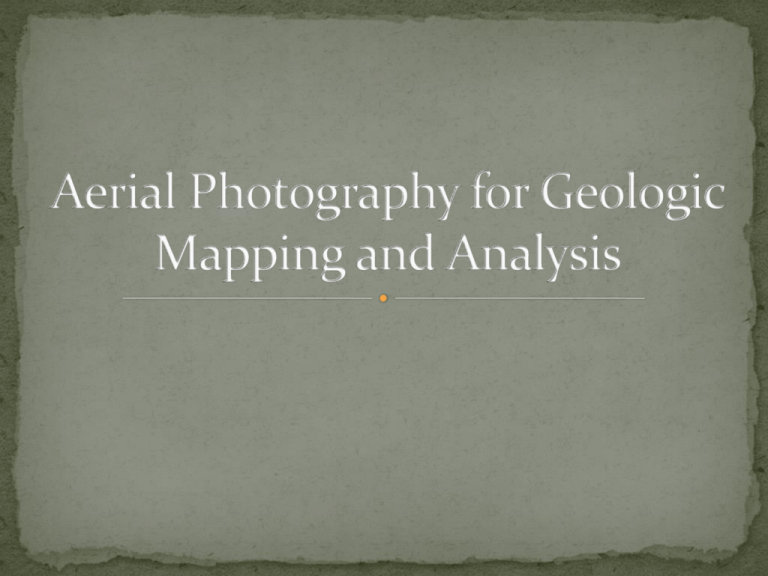Aerial Photography for Geologic Mapping and Analysis
advertisement

Textbook for geologists (2002) Geologic map of the Sheep Mt. Anticline, Wyoming, based on air photos. From Banjeree and Mitra. 2004. AAPG Bulletin 88(9):1227-1237. What are the primary applications of aerial photographs for geologists? Be able to define lithology, structure, and landform, and recognize common examples in air photos. How do drainage patterns help us interpret geology? How can aerial photography contribute to soil mapping? What do we mean by 1st through 5th order soil maps? Lithology Structure Landforms Drainage Soils What do each of these mean?? Devil’s Tower – Lithology? Structure? Surrounding rock?? (Air Photo Courtesy Louis Maher, Jr.) Lithological Units • Igneous • Sedimentary • Metamorphic What are each of these, and what are some examples?? What kind of rock is this? What clues are you using? Igneous Rocks (basalt flows) at Craters of the Moon, ID (Air Photo Courtesy Louis Maher, Jr.) What kind of rock? Sedimentary Rocks (badlands) in South Dakota (Air Photo Courtesy Louis Maher, Jr.) What kind of rock? What’s the scale of this photo? Metamorphic Rock from Grand Canyon (not an air photo!) (Courtesy American Geological Institute) Lithology is an important aspect of geologic mapping Interpretation from air photos requires knowledge of relationship between the lithology and: Climate Topography Drainage pattern Jointing and faulting Texture Vegetation Photointerpretation clues: tone, size, context, shape, etc. Photointerpreters should be trained to understand these relationships on photos and in the field Affects the way rocks weather. Affects the associations of vegetation with particular rock types Affects soil formation from rock parent material Affects erosional patterns All of these influence the appearance of different rocks in photos. Drainage patterns are easy to see on aerial photographs Offer clues to many other geologic characteristics of an area (e.g., topography, bedrock, surface texture and hardness, jointing, etc.) Obvious importance for hydrologic mapping, modeling and management Often influence human land use A. Dendritic Drainage patterns • Dendritic: horizontal sediment or uniformly (homogeneous) resistant bedrock; gentle slope • Parallel: moderate to steep slopes fine textured deposits or fractured bedrock or in areas of parallel elongate landforms • Trellis: dipping or folded bedrock • Rectangular: jointed or faulted bedrock • Radial: volcanoes, domes, basins • Annular: domes or basins • Multibasinal - flat-lying glacial terrain; karst (limestone) terrain • Contorted: metamorphic rocks disc.gsfc.nasa.gov/.../ geo_images_4/Fig4.1.gif Originally from Howard, 1967 B. Parallel What kind of drainage is this? What causes it? Rectangular drainage on Volga River (caused by faulting) (Satellite image) Type of drainage? Dendritic drainage pattern (Photo courtesy Michael Collier) Topography: flat to hilly Drainage: parallel or internal Photo tone: dark or sometimes spotted Gully type: none (not erosive) Igneous Rocks (basalt flows) at Craters of the Moon, ID (Air Photo Courtesy Louis Maher, Jr.) Topography: flat or table like (mesas, etc.) but can be highly eroded Drainage: dendritic Photo tone: light and banded (can vary considerably) Gully type: none to deep depending on steepness Where is this? Can you name these features? Sedimentary rocks (sandstone) at Castle Valley, UT (Air Photo Courtesy Louis Maher, Jr.) Geologic structures are any features caused by deformation of rock (folding, faulting, etc.) Structure is important for trapping hydrocarbons, controlling water flow, understanding stratigraphy, etc. Includes: Strike and dip Folds (e.g., anticlines, synclines, domes, basins, etc.) Faults (e.g., normal, reverse, horst and graben, etc.) Joints Unconformities Can you name this Wyoming feature? Sheep Mountain anticline in Bighorn Basin of Wyoming (Air Photo Courtesy Louis Maher, Jr.) Type of rock? What are the linear features? Sandstone jointing in Arches National Park (Air Photo Courtesy Louis Maher, Jr.) What is this called? Angular Unconformity (Photo by James St. John, Flickr Creative Commons, flickr: jsj1771) Interpreter looks for changes in tone and texture that represent boundaries between geologic units Works best where vegetation cover is minimal But…can sometimes see changes in underlying strata related to changes in overlying vegetation Can sometimes enhance edges with digital filters Can use stereo techniques to measure elevation changes for calculating dip angles Geologic map of Wyoming’s Casper Arch (Image Courtesy NASA.) Geologic structure in California (Image Courtesy of NASA) Definition of landforms varies with discipline Geologist may have different view than soil scientist or hydrologist Creating a landform key is important aspect of aerial interpretation Landforms are strongly influenced by underlying geology and climate Coastal and oceanic (e.g., fjord, ismuth, beach, etc.) Erosional landforms (e.g., canyon, cuesta, gully, etc.) Fluvial (river related) landforms (e.g., braided channel) Mountain and glacial landforms (e.g., cirque, peak, etc.) Slope landforms (e.g., terrace, cuesta, plain) Volcanic landforms (e.g., cinder cone, lava flow) Depositional landforms (e.g., alluvial fans) Etc. (there are many ways to think about landforms) What kind of landform? Where? Glacial moraine near Pinedale, Wyoming (Air Photo Courtesy Louis Maher, Jr.) Great Sand Dunes, Colorado (Air Photo Courtesy Louis Maher, Jr.) Identifying landforms on aerial photography uses many clues Topography Drainage pattern Drainage texture Photo tone and texture Vegetation patterns Land use patterns Scale of landform determines scale of imagery necessary to map. Landforms occur across scales. Soils can be mapped at a wide range of scales and precision 1st order surveys are most detailed and 5th order are least Lower (1st, etc.) order surveys require detail found in air photos Almost all soil mapping requires a combination of field survey and remote sensing Typical project uses manually interpreted aerial photography followed by field work to label the interpreted units Small plot level 1st order 1:8,000 scale Detailed soil map 2nd order 1:20,000 scale Soil association map 4th order 1:250,000 scale Statewide soil map 5th order 1:1,000,000 scale Soil survey on air photo (From Wikipedia) Aerial photography is widely used for various aspects of geology Choice of air photos depends on scale, spectral requirements, etc. Air photo interpretation for geology usually requires a coupled field component Interpreters must have comprehensive knowledge of a broad set of indicators that give clues to underlying geology






